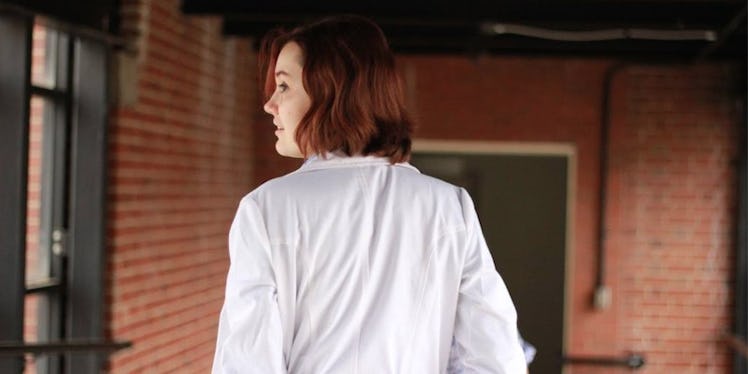It's a well-known fact that being a woman in science is hard. Even just being a woman in general is hard. There are some amazing women in science who have faced their own hardships, including racism, ageism and disability.
These badasses have faced oppression and punched it in the face. If these women can make some of the greatest discoveries of all time, you can do anything.
Here are six badass women who've beaten the odds, and made huge breakthroughs in science:
1. Jocelyn Bell Burnell
Burnell is known for being the first astrophysicist to discover radio pulsars. Pulsars are rotating neutron stars that are highly magnetized. These stars emit beams of electromagnetic radiation (aka, the radiation coming from visible and non-visible light).
Burnell's discovery received a Nobel prize in 1974. But get this: Burnell's partner on the project, Antony Hewish, took the Nobel Prize for their research and excluded Burnell.
Dick move, right? To this day, the fact that Burnell never received proper recognition for her work has been a point of controversy. Burnell went on to become the President of the Royal Astronomical Society, and most recently, the Pro-Chancellor of the University of Dublin.
She proves that even when you've been wronged, it's better to prove your worth than cause a scene. In an after-dinner speech in 1977, Burnell even stated, “Finally, I am not myself upset about it. After all, I am in good company, am I not?”
2. Mae C. Jemison
Jemison is the first female African-American astronaut to travel to space. Jemison, who was born in the '60s, grew up looking at the stars. She often imagined what it would be like up there.
After attending Stanford for biomedical engineering, Jemison realized she still had that childhood dream of traveling to space. Despite being an African-American woman, Jemison applied to the NASA space academy and took her first (and only) flight on September 12, 1992.
During her time in space, Jemison conducted experiments on motion sickness and weightlessness on board the shuttle. Jemison, who was inspired by Martin Luther King Jr., believes that “society should recognize how much both women and members of minority groups can contribute if given the opportunity.”
3. Marie Curie
Curie was born in 1867 in Poland, and is prominently known for her research on radioactivity. At age 24, Marie and her sister were dead-set on continuing their education at a university in Paris.
So, they made a deal. Each of the two sisters would work in order to pay for the other's education. Marie's sister was first, and Marie worked as a governess before that time to support her.
After her sister's time at university, Marie headed to Paris. She subsequently met her future husband, Pierre Curie. While performing her research, Marie found not one, but two different radioactive elements: polonium and radium.
Marie concluded that radioactivity is not a molecular atom. It comes from the atom itself. When gasses are passed through uranium rays, they are able to conduct electricity. These are known as radioactive rays.
Marie Curie was the first and only woman to win the Nobel prize in two categories: physics and chemistry. She was also the first women in Europe to receive a doctorate in science, as well as the first female professor at the Sorbonne Academy in Paris.
She was awarded a legion of honor from the French government after she developed a portable X-ray machine to help with the war efforts. Basically, Marie Curie is the biggest badass of all the badass women in science.
4. Madeleine Gagne
Madeleine Gagne is the founder of the Collins-Miller project, which is an independent research program through Ohio State University. The project revolves around the creation of a clean and safe algae-based energy source that will (hopefully) “make the world a cleaner place.”
You might not believe it, but Gagne is only 16. She began her research from her basement in the seventh grade. Gagne teaches us that age is just a number. No matter what stage of life you are in, you can do anything you put your mind to.
You can learn more about this project here.
5. Ada Lovelace
Lovelace is known as the “enchantress of numbers,” and was the first computer program writer. Born in 1815 to the poet Lord Byron, Lovelace spent much of her childhood ill.
Despite her frequent bouts of illness (including a bout with measles that left her on bed rest for a year), Lovelace insisted she be educated. Lovelace is known for believing there could eventually be machines that could compute symbols and numbers.
At the age of 18, Lovelace met Charles Babbage, a professor at the University of Cambridge who is known historically as the father of computing. Although Lovelace would go on to marry and have children, she kept a close relationship with Babbage. He asked her to translate Luigi Menabrea's article on his (Babbage's) analytical engine (an engine that could make mathematical calculations).
Lovelace not only translated the article, she also added her own notes suggesting the machine calculate a sequence of Bernoulli numbers. These notes share shocking similarities to today's computer programs.
Lovelace taught us it's OK to dream a little. Who knows? Maybe hundreds of years from now, your vision will come true.
6. Carol W. Greider
Greider is a molecular biologist and professor at Johns Hopkins University. After gaining her PhD at Berkeley in 1987, Greider went on to discover telomerase.
Telomerase is a key enzyme used prominently in cancer and anemia research worldwide. It is a repetitive sequence at the end of chromosomes (the DNA of a cell).
Each time a cell divides, the telomeres get shorter. These sequences are often referred to as the molecular clock of the cell.
Believe it or not, Greider is dyslexic. If Carol W. Greider can make some of the best scientific discoveries of our time, you can do anything.
